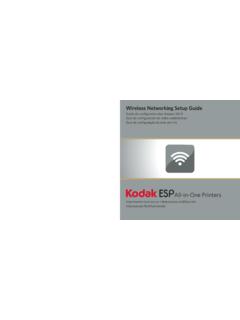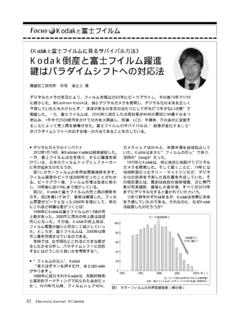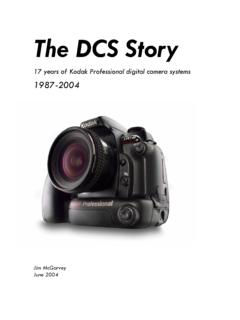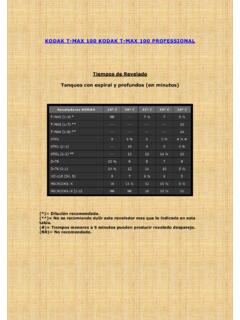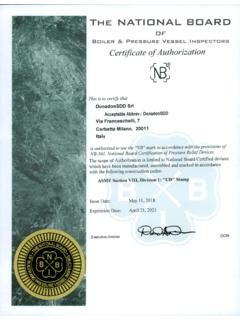Transcription of CHROMOGENIC CHARACTERIZATION A STUDY OF …
1 CHROMOGENIC CHARACTERIZATION : A STUDY OF kodak COLOR PRINTS, 1942-2008. GAWAIN WEAVER AND ZACH LONG. Presented at the 2009 PMG Winter Meeting in Tucson, Arizona ABSTRACT. The Eastman kodak Co. and their coupler-incorporated CHROMOGENIC print process, were nearly synonymous with the 20th century color snapshot. Introduced in 1942 and still manufactured today, samples of these prints from intervals across the manufacturing history were studied in detail in order to gain a fuller understanding of the material characteristics of this photographic process. The following aspects of the prints were examined: support, dye cloud structure, layer order, backprinting and stamps, dye and coupler stability, and fluorescence. The prints were documented overall and in cross-section under both visible and UV radiation, using an Olympus AX-70 compound microscope, and a Canon EOS 5D digital SLR.
2 Changes in the print characteristics over time were documented and when possible, correlated to known technological developments. The documentation of these changes over time made it possible to date nearly any print to within a few years. Subsequent findings from this inquiry significantly add to the knowledge about these ubiquitous yet rarely studied photographic prints. INTRODUCTION. The era of the color snapshot began in January 1942 when kodak introduced Kodacolor--the first consumer-oriented mass production negative/positive color print process. The process, which produced fiber base color prints from color negatives, was dramatically simpler and cheaper than previous alternatives. One of the innovations of this new process was the use of coupler- incorporated negative film and print materials. Issues with color rendition and extremely poor dye stability plagued the process in its early years, though technological innovations led to gradual improvements in print quality and stability.
3 By 1960, color photography overtook black and white in the amateur photofinishing market. A general introduction to the history and technology of CHROMOGENIC materials will lay the foundation for an understanding of print characteristics. Aspects of support, dye cloud structure, layer order, backprinting and stamps, dye and coupler stability, and fluorescence will be examined in detail. NOTE: All references to CHROMOGENIC prints in this STUDY refer to kodak 's coupler-incorporated print materials that were sold under the Kodacolor and Ektacolor names beginning in 1942. Topics in Photographic Preservation, Volume Thirteen (2009). WEAVER AND LONG A STUDY OF kodak COLOR PRINTS, 1942-2008. HISTORY AND TECHNOLOGY. CHROMOGENIC photography is based on silver halide technology, so much so that color prints are often referred to as silver halide prints in industry.
4 The critical step in silver halide photography that we are concerned with here is the developing step: Developer + Silver halide Oxidized developer + Metallic Silver In black and white photography this oxidized developer has no purpose, and is simply washed out of the print as a chemical by-product of the development process. In CHROMOGENIC processes, this oxidized developer is used for the image-wise creation of color dyes. Perhaps the earliest suggestion for using oxidized developer to create color comes from Dr. Benno Homolka, a German chemist. Around 1906, Homolka was investigating the nature of the latent image. Specifically he wanted to determine whether the latent image acted as an oxidizing agent in relation to organic compounds other than typical photographic developers. In order to make this task easier he sought an organic compound whose oxidized form was both colored and insoluble.
5 This way, if the latent image acted as an oxidizing agent, the oxidized organic compound would stay in the emulsion and be visible. He chose two close chemical relatives of indigo dyes, indoxyl and thio-indoxyl. Upon oxidation these convert to insoluble green and red compounds, respectively. While Homolka did note the beautiful photographic effects that could be obtained with these new developers , he did not suggest that these reactions might be useful in the pursuit of a color photographic process (Homolka 1907). A few years later, another German chemist, Rudolf Fischer, would be the first to recognize the potential of oxidized developers in producing a photographic color image. In a patent filed in 1912, Fischer coined the terms color development and color formers (dye couplers), and described the process of CHROMOGENIC negative/positive photography in some detail (Fischer 1913).
6 A year later, he listed the color developers and dye couplers that can be used in combination to produce various colors in the making of colored photographs, many of which are still in use today (Fischer 1914). With Fischer's work we can now complete the CHROMOGENIC chemical reaction: Color developer + Silver halide Oxidized color developer + Metallic Silver Oxidized color developer + Dye coupler Color dye Despite his visionary description of CHROMOGENIC photography, Fischer was not able to create a successful color process. He could not prevent the sensitizing dyes and dye couplers from wandering between the various emulsion layers and causing havoc in the final image. Research at Agfa and kodak in the 1920s and 1930s would finally solve these problems and pave the way for the introduction of Agfacolor Neu in 1936 (a CHROMOGENIC color transparency process) and finally for Kodacolor in 1942.
7 One of the last steps in solving the practical problems of the CHROMOGENIC process was the anchoring of the color couplers to keep them from wandering into other layers or diffusing within their own layer. Agfa was the first to solve this problem. In the early 1930s Wilmanns and Topics in Photographic Preservation, Volume Thirteen (2009) 2. WEAVER AND LONG A STUDY OF kodak COLOR PRINTS, 1942-2008. Schneider, working at Agfa Filmfabrik, discovered that the diffusion properties of dyes within a gelatin layer were dependent on the shape of the dye molecule, and that long molecules did not easily diffuse. This soon led to the development and patenting of dye couplers with long carbon chains attached to keep them in place in the gelatin binder. This was the key discovery that made it possible for Agfa to produce Agfacolor Neu.
8 kodak was working on the same problem, but found a different solution around 1939. They used shorter carbon tails on the dye couplers, making them water insoluble and oil-soluble. They then dissolved these dye couplers in a resinous binder, which was then dispersed as tiny droplets in the gelatin emulsion. This discovery led directly to the introduction of the Kodacolor process in January 1942 (Coote 1993). KODACOLOR/EKTACOLOR TIMELINE. 1942 Kodacolor introduced (very poor dye stability, severe coupler staining). 1949 Orange coupler mask replaces silver image mask in Kodacolor negatives to improve color rendition 1954 Magenta dye stability improved, coupler staining dramatically reduced, dye layer order reversed 1959 Cyan dye stability improved, coupler staining further reduced, OBAs added during processing, backprinting introduced with kodak Penny Seal (EKC logo).
9 1968 Resin-coated (RC) supports and textured surfaces introduced 1974 Optical Brightening Agents (OBAs) added to paper base during manufacture 1988 OBAs added to polyethylene layers CHARACTERISTICS. SUPPORTS. kodak has used 4 different supports since 1942 for their CHROMOGENIC prints: fiber base, resin- coated (RC), polyester, and laminate. Fiber base support was used for kodak CHROMOGENIC prints from their introduction in 1942. until it was replaced by RC support in 1968. Fiber base prints were being produced as late as 1971, as evidenced by a sample book from that year. Fiber base support consists of paper, or raw base as it was called at kodak , and a baryta coating. Here is a list of additives to kodak 's raw base from 1945: Muriatic acid (pH adjustment). Melamine-formaldehyde (Wet strength agent). Aluminum chloride Topics in Photographic Preservation, Volume Thirteen (2009) 3.
10 WEAVER AND LONG A STUDY OF kodak COLOR PRINTS, 1942-2008. Stearic Acid/NaOH (produces sodium stearate, and mixes with AlCl3 to make Aluminum Stearate which acts as an internal size providing increased water resistance). Gelatin tub size (external gelatin size, could provide wet strength if hardened, generally acts as a surface sizing agent, holds down the paper fibers, etc.). Blue dye used in most papers Magenta dye used in about 5% of papers Corn starch (dry strength). Beater gelatin (dry strength). RC supports were made by sandwiching the raw base between layers of polyethylene (PE). The emulsion-side PE layer was pigmented with titanium dioxide (TiO2). TiO2 imparts opacity and whiteness to the pigmented PE layer, replacing the visual function of the baryta layer in fiber base prints. Both rutile and anatase forms of TiO2 have been used, though surface treatments have been changed over time to reduce the light induced oxidation of the RC support which is catalyzed by TiO2.
